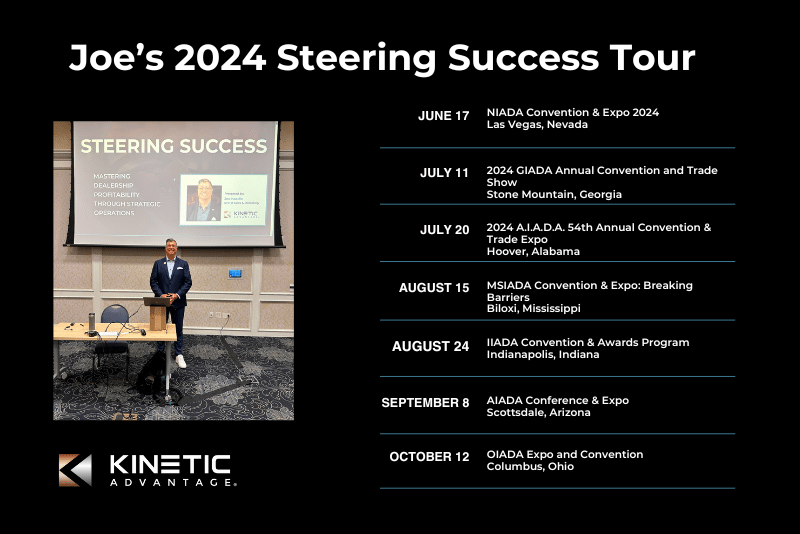
Written by:
Joe Keadle
SVP of Sales & Marketing
Kinetic Advantage
This article was originally published by Joe Keadle for FIADA’s Florida Independent Dealer Magazine, August 2025 Edition
In today’s fast-paced, margin-sensitive automotive market, independent dealers are navigating a new era of challenges: tighter inventory supply, rising holding costs, and rapidly shifting consumer demand. In this environment, the ability to buy the right vehicles quickly, affordably, and with agility has never been more important.
Inventory acquisition is not just about “having cars on the lot”; it is a competitive advantage. And at the heart of successful acquisition is smart, flexible financing and disciplined inventory strategy.
In today’s fast-paced, margin-sensitive automotive market, independent dealers are navigating a new era of challenges: tighter inventory supply, rising holding costs, and rapidly shifting consumer demand. In this environment, the ability to buy the right vehicles quickly, affordably, and with agility has never been more important.
Inventory acquisition is not just about “having cars on the lot”; it is a competitive advantage. And at the heart of successful acquisition is smart, flexible financing and disciplined inventory strategy.

Understanding the Core Financing Types: Equity, Bank Lines of Credit, and Floorplan Financing.
Before diving into the tools and strategies for smarter inventory management, it is important to examine the three primary ways independent dealers fund inventory, along with their trade-offs.
1. Equity (Self-Funding)
Using personal or business capital to purchase inventory outright.
Pros:
- No interest or third-party involvement.
- Total purchase control and ownership.
Cons:
- Ties up working capital.
- Limits buying power and growth potential.
- Opportunity cost of not investing in other areas.
2. Bank Line of Credit
A general-purpose line from a traditional bank.
Pros:
- Lower interest rates possible.
- Flexible usage across business needs.
Cons:
- Often lacks inventory-specific features.
- Slow approval processes.
- May require restrictive collateral.
- Most banks prefer an all-eggs-in-one-basket approach, meaning they will want all aspects of your dealership to be there: the line of credit, your operations & payroll accounts, credit card machine, etc., and all those tied together.
3.Floorplan Financing
Revolving credit specific to inventory acquisition, where the lender holds the title until the vehicle is sold.
Pros:
- Optimized for vehicle turn and scaling inventory.
- Enables real-time auction integration and capital access.
- Improves liquidity without draining operations.
Cons:
- Fees accrue if turn is slow.
- Requires strategic inventory and cash flow management.
- Some providers lack transparency in fee structure.
How Floorplanning Can Support You for Smarter, Faster, More Flexible Inventory Acquisition
Floorplanning can be a growth engine—but only when paired with disciplined inventory practices. Dealers must approach acquisition with clear expectations for turn, pricing strategy, and exit timing.
Inventory Turn Strategy: Targeting 60 Days
Many high-performing dealerships today run with a focused 60-day turn target. Beyond that threshold, vehicles begin to lose profit margin and become dead weight on the lot. Avoiding lot rot, capital tie ups, and additional daily holding costs are key.
A disciplined turn strategy includes:
- Age Buckets: Have defined stages (0–30 days, 31–45 days, 46–60 days) with action plans at each stage. reprice to market, vehicle recondition check-ins, sales incentives.
- Drop-Dead Dates: Create strict deadlines for liquidation, wholesale, or auction by day 60.
- Turn Triggers: Set conditions (e.g., price drops, recon spend limits) that automatically activate before expenses mount.
This disciplined approach helps prevent aged units from compounding holding costs or damaging cash flow.
Pricing to Market: Real-Time Adjustments Based on Data
Dynamic pricing is essential in today’s market. Dealers should use tools that help them:
- Compare vehicle prices across retail and wholesale channels.
- Monitor competitive pricing within their market radius.
- Adjust weekly if not daily based on your market’s price drops, competitor listings and wholesale market activity.
Successful dealers shift from intuition-based pricing to data-informed, real-time updates that help move vehicles faster without unnecessary margin erosion.
Exit Planning: Know When to Let Go
Not every unit will sell retail. That is why the best inventory managers have stopped following the theory that there is a butt for every seat and now have clear plans:
- Defined inventory aging policy up front—typically between 45-60-90 days.
- Planned exit strategies that include wholesale thresholds or auction backup if they cannot sell to a consumer.
- Rely on performance metrics—not emotions—to make final hold/sell decisions.
The difference between 60- and 90-day turn cycles can be thousands of dollars in holding costs and opportunity loss.
Find Tools That Power Your Inventory Management Practices. Let us look at one: The Inventory Report Card
Modern inventory management needs more than spreadsheets. Tools like the Inventory Report Card from One Auction View help dealers track, analyze, and act across their entire inventory portfolio.
Key features that support smarter acquisition and faster turn include:
Real-Time Market Intelligence
Compare your vehicle pricing with current retail market data across platforms like Autotrader, Cars.com, and more—automatically and daily. For example, The Inventory Report Card benchmarks your units against retail comps and auction trends, helping you spot overpriced, stagnant, or overlooked opportunities across platforms daily.
Turn Performance Metrics
Sort units by age, price rank, and turn efficiency so you can instantly find problem inventory. Dealers can rank and filter units by Days On Lot, Price and market velocity to target area of opportunity.
Vehicle “Health” Scores
Score each unit by age, price-to-market, retail presence, and lead activity to show which cars are thriving—and which are stagnating.
Profitability Forecasting
Receive alerts when units are nearing your cost threshold or projected profit turns negative—so you can act before it is too late.
Daily Inventory Alerts
Flag high-risk inventory (longest aged, no price drops, recondition issues, etc.) so you and your team know where to focus every morning. Learn to hate old inventory!
Together, these tools can enable dealers to treat inventory management like a financial portfolio—with visibility, accountability, and responsiveness. Every dealer needs to find the right tool to support their inventory management strategies.
Assessing a Floorplan Lender: What to Look For
Assessing a Floorplan Lender: What to Look For
Choosing the right floorplan partner is critical to supporting your 60-day strategy. Here is how to evaluate:
Final Takeaway: Smarter Acquisition Requires Skillful Management
Dealers who thrive in today’s market are combining smart financing, real-time inventory tools, and a firm grip on their turn and pricing strategy. Self-funding and bank credit may offer security, but floorplan financing—used wisely—offers unmatched flexibility and scale.
And when paired with modern inventory platforms like the Inventory Report Card, dealers can make faster decisions, improve turn, and reduce aged unit exposure.
Inventory acquisition is not just about buying the right car. It is about buying with purpose, managing with data, and knowing exactly when to let go. Hate those aged inventory units!

What Drives You?
What Drives You?
The dealership floorplanning newsletter that takes a look into recent floorplan news & trends, as well as updates from inside the walls at Kinetic Advantage.
(We promise not to spam you or inundate your inbox with emails. Our newsletter goes out roughly twice per month to include important news and information around dealer floorplanning.)






